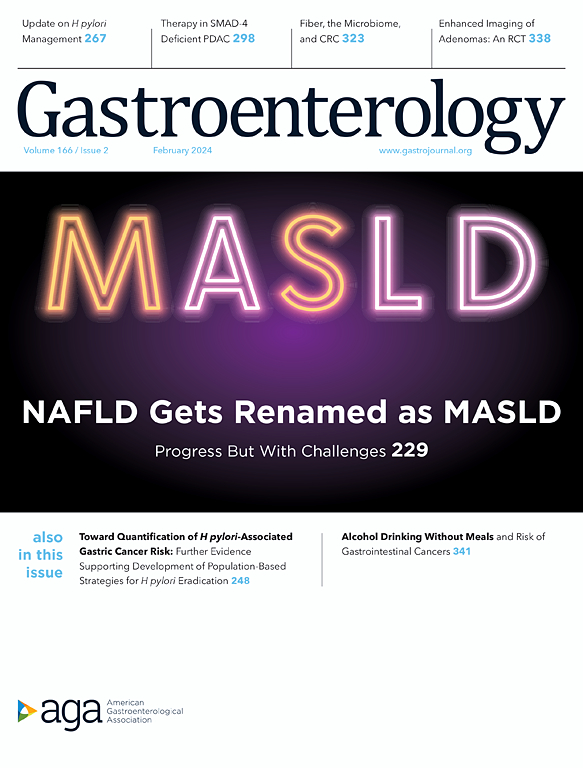血糖定义的新发糖尿病的胰腺癌风险:一项前瞻性队列研究
IF 25.7
1区 医学
Q1 GASTROENTEROLOGY & HEPATOLOGY
引用次数: 0
摘要
背景:在回顾性研究中观察到的新发糖尿病(NOD)后3年胰腺癌发病率增加需要前瞻性验证。目前尚不清楚发病率是否因种族/民族而异。方法在一项前瞻性、观察性研究中,使用电子健康记录的主动实时监测,我们确定了18838名50岁的成年人,根据血糖标准(GNOD)定义NOD。在这个中期分析中,我们报告了gnd后诊断为胰腺癌的比例的3年Kaplan-Meier估计(绝对发病率(95%置信区间))和相关的标准化发病率(SIR)的种族/民族;美国3年胰腺癌总发病率调整糖尿病种族分布;以及gnd与胰腺癌诊断之间的间隔。结果中位随访2.3年,确诊胰腺癌82例(男性60%,平均年龄71±8岁)。3年胰腺癌诊断比例(95% CI)和相关SIR (95% CI)的种族/民族估计为:非西班牙裔白人(n=6,518) 0.84% (CI: 0.60, 1.07) (SIR 6.4 (CI: 4.8, 8.4));西班牙裔(n = 5984) 0.40%(0.20, 0.60)(爵士4.2 (2.6,6.3);非裔美国人(n= 2192) 0.37% (0.07, 0.67) (SIR 2.4(1.0, 5.0)),亚洲/太平洋岛民(n= 3360) 0.22%(0.07, 0.67)。(先生,3.0(1.4,6.0)。总体而言,种族调整后的3年胰腺癌发病率为0.62%。gnd平均发生在临床诊断前8个月;0 ~ 4个月30.5%,4 ~ 12个月31.3%,12 ~ 24个月19.5%,24 ~ 36个月18.7%。结论:血糖定义的新发糖尿病,可通过电子健康记录的主动监测实时识别,与3年胰腺癌的高发病率相关,且存在明显的种族/民族差异。长期风险需要进一步研究。本文章由计算机程序翻译,如有差异,请以英文原文为准。
RISK OF PANCREATIC CANCER IN GLYCEMICALLY DEFINED NEW-ONSET DIABETES: A PROSPECTIVE COHORT STUDY
BACKGROUND
Increased 3-year incidence of pancreatic cancer following new-onset diabetes (NOD) observed in retrospective studies needs prospec4ive validation. It is unknown if incidence varies by race/ethnicity.METHODS
In a prospective, observational study using active real-time surveillance of electronic health records we identified 18,838 adults >50 years of age with NOD defined by glycemic criteria (GNOD). In this interim analysis, we report 3-year Kaplan-Meier estimates of proportion diagnosed with pancreatic cancer following GNOD (absolute incidence (95% Confidence Intervals)) and associated Standardized Incidence Ratio (SIR) by race/ethnicity; overall 3-year incidence of pancreatic cancer adjusting for racial distribution of incident diabetes in the United States; and interval between GNOD and pancreatic cancer diagnosis.RESULTS
During median follow-up of 2.3 years, 82 pancreatic cancers have been diagnosed (60% male, mean age 71±8 years). The 3-year estimates for proportion diagnosed with pancreatic cancer (95% CI) and associated SIR (95% CI) by race/ethnicity were: non-Hispanic Whites (n=6,518) 0.84% (CI: 0.60, 1.07) (SIR 6.4 (CI: 4.8, 8.4)); Hispanics (n=5,984) 0.40% (0.20, 0.60) (SIR 4.2 (2.6, 6.3)); African Americans (n=2,192) 0.37% (0.07, 0.67) (SIR 2.4 (1.0, 5.0), and Asian/Pacific Islander (n=3,360) 0.22% (.06, 0.39) (SIR 3.0 (1.4, 6.0). Overall, race-adjusted 3-year pancreatic cancer incidence was 0.62%. On average GNOD occurred 8 months prior to clinical diagnosis; 0-4 months in 30.5%, 4-12 months in 31.3%, 12-24 months in 19.5%, and 24-36 months in 18.7%.CONCLUSIONS
Glycemically defined new-onset diabetes, identifiable in real-time using active surveillance of electronic health records, is associated with a high 3-year incidence of pancreatic cancer with marked racial/ethnic differences. Longer term risk needs further study.求助全文
通过发布文献求助,成功后即可免费获取论文全文。
去求助
来源期刊

Gastroenterology
医学-胃肠肝病学
CiteScore
45.60
自引率
2.40%
发文量
4366
审稿时长
26 days
期刊介绍:
Gastroenterology is the most prominent journal in the field of gastrointestinal disease. It is the flagship journal of the American Gastroenterological Association and delivers authoritative coverage of clinical, translational, and basic studies of all aspects of the digestive system, including the liver and pancreas, as well as nutrition.
Some regular features of Gastroenterology include original research studies by leading authorities, comprehensive reviews and perspectives on important topics in adult and pediatric gastroenterology and hepatology. The journal also includes features such as editorials, correspondence, and commentaries, as well as special sections like "Mentoring, Education and Training Corner," "Diversity, Equity and Inclusion in GI," "Gastro Digest," "Gastro Curbside Consult," and "Gastro Grand Rounds."
Gastroenterology also provides digital media materials such as videos and "GI Rapid Reel" animations. It is abstracted and indexed in various databases including Scopus, Biological Abstracts, Current Contents, Embase, Nutrition Abstracts, Chemical Abstracts, Current Awareness in Biological Sciences, PubMed/Medline, and the Science Citation Index.
 求助内容:
求助内容: 应助结果提醒方式:
应助结果提醒方式:


